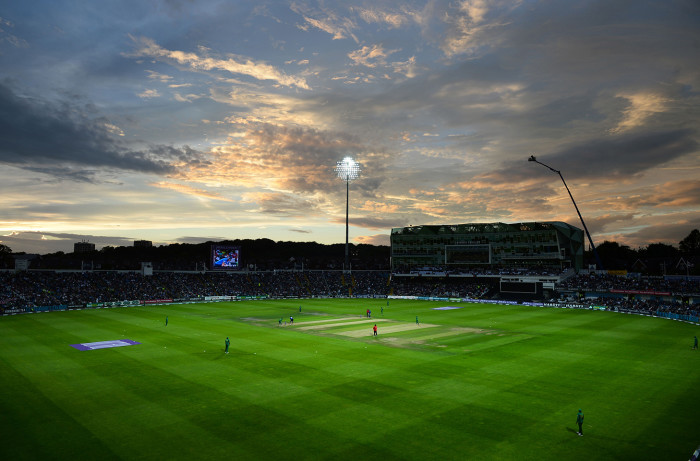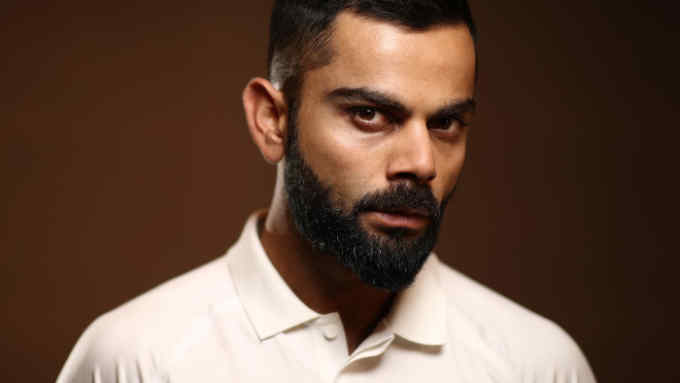Can The Hundred save English cricket?
Roula Khalaf, Editor of the FT, selects her favourite stories in this weekly newsletter.
November 2017, London. At a secret meeting in an undisclosed location, Tom Harrison, chief executive of the England and Wales Cricket Board, the sport’s national governing body, is being run through a slideshow presentation on the future of the game. English cricket is sleepwalking through a demographic crisis, he is told. In the UK, the sport retains a mainly white, affluent, middle-aged-male audience. Beyond this privileged set, the appeal fades.
The findings are from four years of surveys, taking in the responses of more than 100,000 people on their attitudes towards cricket. Of the 10.5 million “followers” interested in the sport, 1.1 million actually attend matches. The amount of people playing the game is falling. Only 5 per cent of children aged between seven and 15 years old list cricket in their top two favourite sports. The average age of an English cricket fan is 50.
Harrison, a white, affluent, privately educated 47-year-old already knows this. The research has been circulating within the ECB for months. To his surprise, the last slide proposes a solution: The Hundred, a tournament in which each innings lasts just 100 balls, creating a faster, simpler, more accessible version of the game.
“My instantaneous reaction was: I love it,” recalls Harrison when I meet him at the ECB’s offices at Lord’s, the famous London ground that is known as “the home of cricket”. “I absolutely love it. I can actually feel the hairs on my neck just thinking about that moment, that sense of, ‘Wow, this is powerful.’” Then he adds: “Very quickly afterwards [there was] a kind of dose of reality. This isn’t going to be straightforward.”
The Hundred may not sound like a revolution. Last year, the ECB invited an elite group of coaches and players to a two-day workshop to brainstorm innovations, from increasing the size of teams to even, for a few seconds, eliminating the “leg before wicket” rule. Most were not taken up, though some, such as strategic “time-outs”, were. But when it launches in July next year, the game will still feature bat v ball, a duel of willow against leather over 22 yards on a grass pitch.


Beneath the surface, though, lies a more subversive design. Millennial audiences have ever-narrowing attention spans, but have ever-greater ways to be entertained. Cricket is not alone in responding to this challenge. The ATP, the body that runs men’s professional tennis, has launched a tournament dedicated to experiments such as using a “shot-clock” to limit the time a player has before serving.
In the US, American football, basketball and baseball have all introduced rule changes to speed up the pace of play. The ECB’s plan goes a lot further. It is spending £180m to create new teams featuring the country’s best players, right in the heart of the summer cricket season. English cricket is making an all-in bet on an untested proposition.
The sport has accepted the need for speed. This summer will feature The Ashes, a Test series between Australia and England that first took place in 1877, featuring matches that last up to five days, yet can still end in a draw. But later this month also marks the start of the cricket World Cup in England, where games are crunched into a single day. Last week saw the conclusion of the Indian Premier League, a money-spinning competition launched in 2008, featuring “Twenty20” matches that last just a few hours. The Hundred slims cricket down even further.
Some argue this is unnecessary and may even harm the game. One top English cricket executive, who declines to be named fearing the wrath of the ECB, says it is like inventing Gaelic football, a game beloved in Ireland, but incomprehensible outside those shores. “To add a fourth format that won’t be played anywhere else, that has no international relevance, is a real dichotomy for the game,” the executive says.
In nondescript offices overlooking the lush, green practice pitches of Lord’s, I meet the team of officials reimagining an ancient game. Over several hours of interviews, they provide the deepest insight yet into the project, though much remains shrouded in secrecy. Their work has led to a fierce debate raging across the game. Is The Hundred a necessary and vital departure, pointing to a brighter future for other sports? Or an expensive and foolhardy attempt to reach the masses, while alienating cricket’s loyal fan base?
The man who pitched The Hundred to Harrison is a Scot. Sanjay Patel was brought up in the small town of Alloa and played for Scotland’s national cricket team. He spent several years as an executive in the drinks industry before joining the ECB in 2014. In February, the 46-year-old became managing director of The Hundred, tasked with bringing the new tournament to life.
According to Patel, The Hundred is a silver bullet to solve a trio of problems. First, time. Even the shortest form of the game, Twenty20 matches (in which each innings lasts 120 balls in total), lasts three to four hours, much longer than comparable events, such as a football match. Second, complexity. In cricket’s Byzantine scoring system, newcomers must follow runs scored, overs bowled, wickets taken, among myriad other statistics. Third, perception. Too few outside cricket’s establishment see it as a game for them.
The Hundred addresses each of these issues, says Patel. Games will be completed within two and a half hours. And spectators can track a game through a countdown of balls and accumulation of runs. “We felt when cricket was at its best, it was really simple,” he says. “There’s 30 runs required and there’s 15 balls left. That’s when cricket becomes so accessible to a wider audience.”
The Hundred’s main method for dealing with the game’s “stale, male, pale” conundrum is to break with almost 130 years of tradition. In English county cricket, competitions feature 18 “first class” counties, representing historic geographic districts around the country — from Durham in the north to Sussex in the south. Instead, The Hundred will involve eight new city-based franchises in Birmingham, Cardiff, Leeds, Manchester, Nottingham, Southampton and London (one at the Oval and one at Lord’s).
The ECB says its shift is justified by research, which shows that the growing urbanisation of modern Britain means people now associate more closely with cities than with the “shires”. Still, in order to convince existing counties to accept being swallowed up by metropolises, Harrison, alongside ECB chairman Colin Graves (one of the few ECB executives not made available for interview) pledged to give each county £1.3m from the proceeds of the new competition as an incentive to vote in favour of creating it. For most, the cash will be the difference between making a profit or loss.
Little is known about the new franchises. A year out from the start of the tournament, teams do not have fixed staff, players, names, branding, jerseys or colours. Rob Caulder, the ECB’s commercial director, another Scot though one with a predilection for management speak, pleads for patience. “We spoke to people inside cities [to understand] what were the different aspects of identity in each,” he says. And what did he find? Caulder stiffens. Only when pushed, does he provide the vaguest of insights. This includes that Mancunians are proud of their city as a home to renowned sports teams and music acts. How such information will be used to guide the creation of new franchises is, for now, anyone’s guess.
Last month, ECB officials travelled far from cricket’s heartlands to Nashville, Tennessee. They were there to watch the annual “Draft” for the National Football League, in which 32 NFL franchises select from the best young prospects in American football. The drama is played out live on television, as expectant fans wait to see who will join their side.

The trip was a reconnaissance mission. In October, the ECB will hold a player draft for The Hundred. It too will be televised live and act as a coming-out party for the tournament. “It creates a bit of excitement,” says Patel. “A bit of noise.” In the draft, team bosses will select from the 400 professional male cricketers in England and Wales, as well as scores of overseas internationals.
Each team in The Hundred will have a squad of 15 players, with three places reserved for prestige foreign signings. Reports suggest players will be paid anything between £25,000 and £120,000. At the top end, these salaries are higher than most cricketers earn for an entire season — though the very best are paid hundreds of thousands of pounds for participating in India’s IPL tournament.
Choosing players in this way represents another break with the county game. Joe Root, current England Test captain, is a proud Yorkshireman who has represented his home county since the start of his career. What if he fails to be selected by the Leeds franchise that will play at Yorkshire’s home ground of Headingley? How will fans react if Root’s prized batting is secured by an outfit based hundreds of miles away in Cardiff or Southampton?
The ECB believes enough fans will embrace a change of allegiances while Harrison insists the best players in the world will feature in The Hundred. However, Virat Kohli, the Indian captain who is cricket’s brightest superstar, has declared no interest in playing. Besides, the BCCI, the body that runs Indian cricket, does not allow male Indian players in the IPL to participate in rival global contests. This will limit interest for the tournament in the world’s biggest cricket market, which comprises hundreds of millions of avid viewers.
Can The Hundred become a truly international tournament? Harrison is talking to BCCI about relaxing its policies. “I promise you one thing, 100 balls has got the attention of the powers-that-be in India in a way that perhaps we haven’t managed to in the past. It’s a sign that we’re really thinking differently and thinking probably in a much broader sense about how we grow the game,” he says.
The plan in the meantime? Build it and they will come.
At Lord’s in 2017, a sold-out crowd of 26,500 watched England’s female cricketers manage something their male counterparts have failed to do: win the coveted World Cup. Clare Connor, a former England women’s captain and now the ECB’s managing director of women’s cricket, noticed a few other firsts that day. Queues for the women’s toilets were longer than those for the men’s. Lines to buy coffee were as long as those for the bar. There is a belief at the ECB that more diverse crowds can also be attracted for The Hundred, with each franchise fielding men’s and women’s sides.


Equal billing does not mean equal pay. There will be no draft of women, with the best paid receiving, at most, £15,000, according to Connor. There are only 21 full-time, professional female cricketers in the country, though the ECB says the “aspiration” is to create a further 80 to 100 semi-professional players next year. In the bigger picture, however, The Hundred is seen as a way of moving the women’s game towards parity in more ways than pay.
“One story that I heard after the women’s World Cup final: a friend took his son and daughter,” says Connor. “His son said afterwards: ‘Daddy, my new favourite player is [England bowler] Anya Shrubsole.’ If we can get boys and girls talking about men’s and women’s cricket on a completely kind of equal footing . . . [then] we break down this assumption that if you’re talking about a cricket team, then it’s about men’s cricket.”
In 2005, England won The Ashes in a series watched by millions on Channel 4, a free-to-air UK broadcaster. The England team were given an open-top-bus parade, with fans packing London’s streets to herald the victory. Mainstays of that side, such as Andrew Flintoff and Kevin Pietersen, became regulars on talk shows and wrote best-selling memoirs.
The same year, the ECB converted popularity into hard money. It conducted a £220m deal handing exclusive rights to screen live English cricket matches to Sky, the pay-TV network. Hardcore fans reached into their pockets to get Sky subscriptions. Casual viewers rarely stumble across English cricket on their screens these days.
Harrison was determined to get more people to watch cricket, without sacrificing its cash cow. In June 2017, the ECB made a £1.1bn broadcast deal with Sky and the BBC, the largest commercial deal in its history. While Sky retains the bulk of TV rights, the taxpayer-funded BBC gained 10 live matches from a new domestic Twenty20 competition.
Only later did the ECB change the format to The Hundred. Stephen Lyle, the BBC’s head of televised cricket coverage, insists it did not demand the transformation but welcomes that matches will fit more snugly within its schedules. “The key thing for us really, let’s be honest, it’s quicker,” says Lyle. “Newness, innovation, these are all good words in the TV world.”
To attract the uninitiated, Lyle promises The Hundred will be showcased differently from how cricket has been displayed in the past. Onscreen graphics will be stripped back, focused simply on balls, runs and wickets. There will be a focus on “entertainment first”; there will be expert pundits, he says, but also celebrities and even comedians to accompany viewers through a game.
In the cricketing press, such ideas have been met with bemusement, if not vitriol. “The Hundred’s mania to be different makes it grimmer by the minute,” lamented The Guardian; “The Hundred is now a total laughing stock,” added The Times. The thrust of the criticism is clear: why impose so much change, so quickly?
The ECB has ploughed on regardless. “When you’ve got three years from the decision to do something [to] the first ball being bowled, there’s an awful lot of time for people to fill the void,” says Harrison.
There is only one thing, he believes, that will stop The Hundred being a roaring success: weather. A month of downpours would destroy the tournament. Rather optimistically, Harrison has even held discussions with Google X, the US technology giant’s experimental laboratory, about creating a system that can prevent rain showers over a cricket ground. “One of the things we have to address is cricket’s susceptibility to poor weather,” he says.
Such futuristic solutions will not be ready for next year’s launch. Instead, the legacy of the ECB’s current leaders will be The Hundred. Don’t judge it now, urges Harrison. Wait to see if other sports take drastic steps to shorten play. See if cricket matches will break out on public squares, parks and playgrounds. “It’s not necessarily a game that [must be] positioned in middle England . . . It doesn’t need to be that,” he says. “In India, in the maidans of Mumbai, it’s the game of the people. Everyone loves it. Everyone plays. You can play with a bat and a ball. You don’t need a pair of whites and a helmet and a pristine cricket ground.”
Harrison speaks with an evangelist’s zeal. With The Hundred, he and English cricket’s chiefs are willing to risk being exposed as false prophets. “I’ll be judged in 10 years’ time, long after I’ve left this job,” he says. “I’m terrified [that] I’ll wake up and say, ‘God, we had an opportunity to do something exceptional and we didn’t take it’.”
Murad Ahmed is the FT’s sports correspondent
Follow @FTMag on Twitter to find out about our latest stories first. Subscribe to FT Life on YouTube for the latest FT Weekend videos

Comments